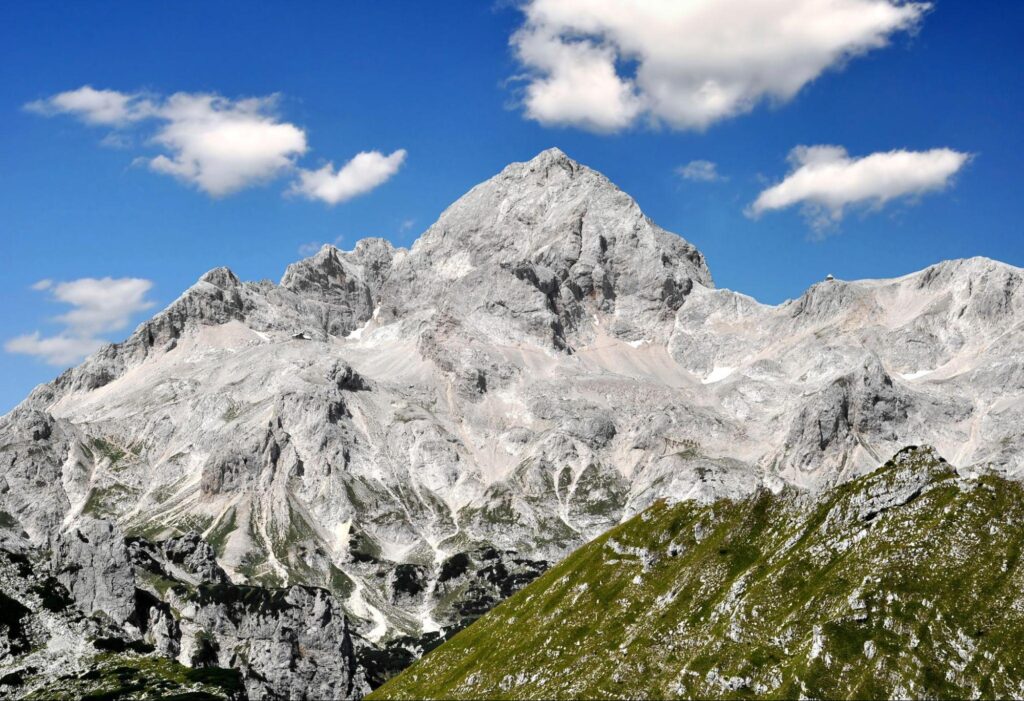Mount Triglav is the highest peak in the Julian Alps and the highest summit in Slovenia. It is the symbol of Slovenia and the most popular climb in the country. It is said you are not a true Slovenian until you climb to its top.Triglav was first climbed in 1778 when four brave men stood on its summit. At the time it was an extremely difficult climb, especially the knife sharp ridge connecting Little Triglav with the main sumit. It was so narrow, they had to ride it like a horse! Later, when mountaineering got more popular, the ridge was artificially widened and Triglav became more accessible to regular people that wish to enjoy its view. And what a view it is – because of the summits prominence, one can view almost all the country from its top, from the Adriatic sea, Adriatic Sea, Italian Dolomites, Austrian Hohe Tauren, the Kamnik-Savinja Alps, and across most of Slovenia to the Pohorje Hills.In 1895, a local priest and Slovenian patriot Jakob Aljaž bought the land on the top of Triglav and built a small shelter there – The Aljaž Tower, symbolically making Triglav forever a Slovenian peak and a national symbol.
![]()
Climbing Triglav
Climbing Mount Triglav is not easy but very rewarding. Most people can do it if they approach the challenge with the right mindset. Most people need 6-7 hour to reach the summit from the valley, so sleeping in one of the huts on the way is recommended. Tho huts come especially hand when climbing Triglav – Kredarica hut and Planika hut. They are situated very high up at around 2500 m and therefore offer basic comfort – everything must be flown up by a helicopter and the running water is not drinkable because it is collected from the rainfall. But because of a high altitude location, it takes only around 1-2 hours to the top from the huts, making it also a much safer ascent in case of a sudden summer storm.The best season for climbing Triglav is late summer when the snow is gone and afternoon heat storms are not as frequent as earlier in the summer. The best months are August and September, when the climb can get pretty crowded, especially during the weekends – many Slovenians climb the mountain each year. Therefore the early booking of accommodation in the huts is highly advisable.Winter ascents are rare, because the last part of the climb is very steep and the cables and in-situ protection is covered with snow, making it a climb only reserved for very experienced mountain climbers. The ascent to the Kredarica hut is relatively easy in winter and very popular, mostly with tour skiers. It is also possible to ski down from the summit of Triglav, which is one of the hardest extreme ski routes in Slovenia and only done every few years when there are perfect conditions.
![]()
The best Triglav climbing routes
There are plenty of marked routes to the Triglav peak. The easiest and most popular is the one from Krma valley, passing Kredarica or Planika hut. The first part is relatively easy, while the summit push is demanding and steep no matter what route we take. Also popular is the route from Pokljuka which is longer but arguably more scenic. The hardest routes are from Vrata valley that go by the side of the mighty Triglav North Face. Those routes are steep and exposed for most of the time, suitable for experienced mountaineers that seek exposure and adrenaline. The Triglav North Face is one of the largest walls in the Alps, 4km wide and 1000m high – it is home of more than 100 climbing routes of all difficulties that attract hundreds of alpine climbers each year.
Do I need a guide for climbing Triglav?
Most people will have a much better experience
climbing Triglav with a guide. An experienced guide will take care of the logistics of the climb, will propose the best timing according to the weather forecast and make sure everything is safe and sound. It is not uncommon for bad weather to strike highlands of the Julian Alps and navigating in for can be extremely demanding due to zero vegetation and indistinct paths on stony landscape. The upper part of the Trigala climb is very exposed and steep and most people feel best when securely tied onto a rope of a professional guide. Choosing a great guide, you will also learn useful hiking and climbing techniques, and some interesting facts and anecdotes about the places you hike.
![]()


